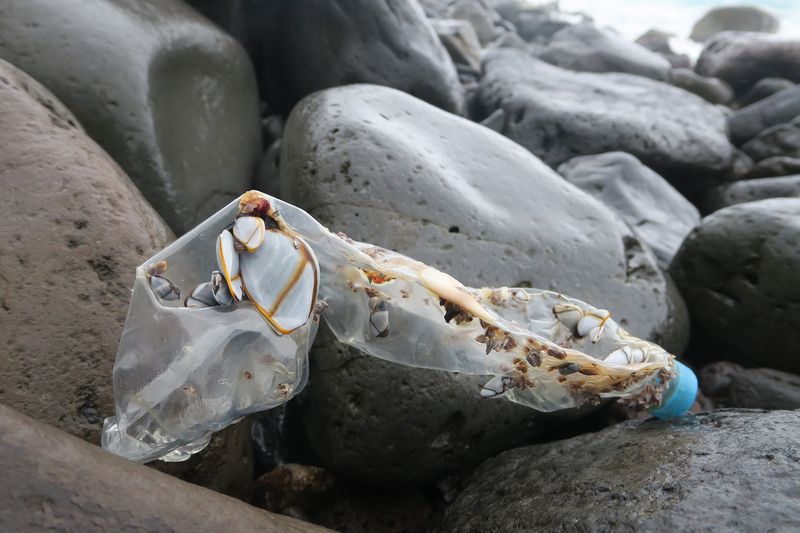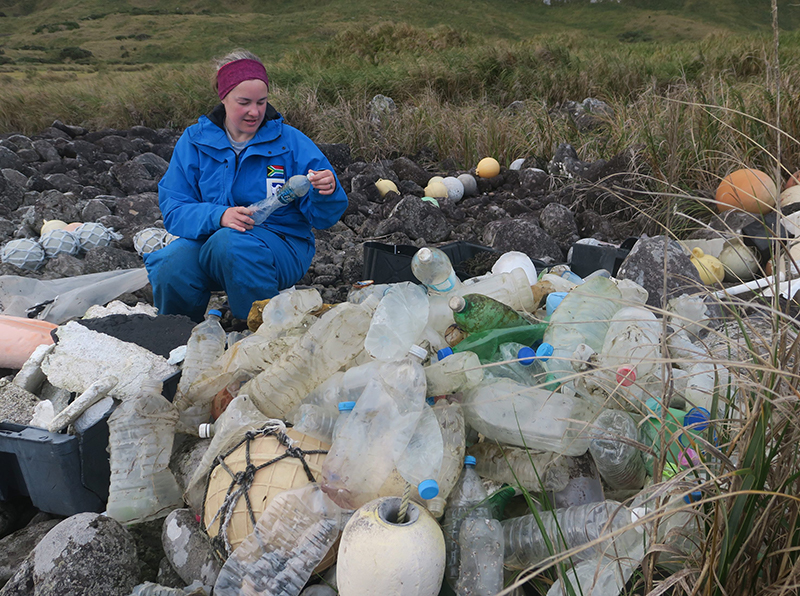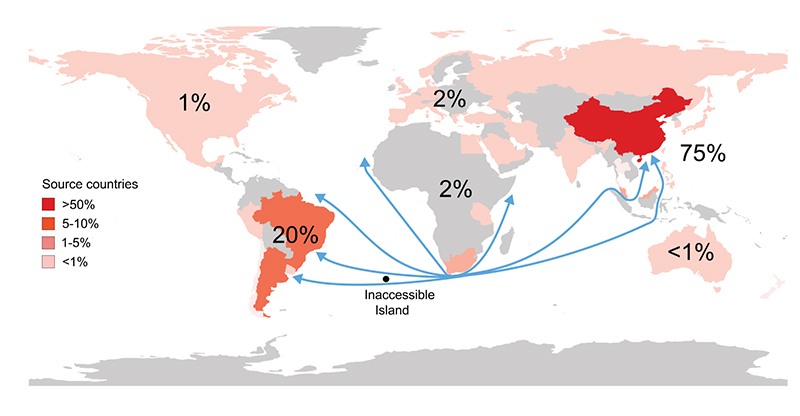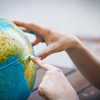Dumped at sea: plastic pollution in the South Atlantic
01 October 2019 | Story Lisa Boonzaier. Photos Peter Ryan. Read time 10 min.
Thousands of kilometres from any continent lies Inaccessible Island, small and isolated in the Southern Atlantic Ocean. Yet, it is full of plastic and a growing proportion of it seems to come not from land, but rather from ships dumping their litter at sea in contravention of international law. That is according to new research led by the University of Cape Town (UCT), which casts doubt on the widely held assumption that most marine plastic now comes from land-based sources.
Pervasive plastic
Since the 1950s, the global production of plastics has grown by about 8% per year and now stands at more than 300 million tonnes per year. Most waste plastic goes into landfills or ends up in the environment.
Because plastic is relatively light, it can disperse far from the places it’s produced – blown by the wind or carried by waterways and on ocean currents. Plastic is now found throughout the world’s oceans – from pole to pole, and to the deepest ocean trenches.
Understanding where litter comes from is essential to figuring out how to fix the problem.
In the ocean, floating plastic litter tends to gather in ‘garbage patches’ in the centre of ocean basins due to rotating ocean currents, known as gyres. One such gyre is in the central South Atlantic Ocean, between southern Africa and South America.
Understanding where litter comes from is essential to figuring out how to fix the problem.
Since the dumping at sea of plastics – and other wastes that are slow to degrade – was banned in 1989, it has been widely assumed that some 80% of litter in the sea comes from on land. However, we have little hard evidence to confirm the importance of land-based sources for plastic in remote areas.
“Recent studies of litter in the North Pacific garbage patch and remote islands in the Pacific Ocean show that fishing gear and other shipping-related equipment account for much of the mass of plastic at sea,” says UCT Professor Peter Ryan, an expert on marine plastics who led the research.
“The challenge comes in understanding the origin of ‘general’ litter – food packaging and domestic products – which could come from ships or land-based sources.”
Caught in a whirlpool
Ironically, isolated oceanic islands – many thousands of kilometres from land – can become catch-alls for ocean waste when they are near a gyre. Their shores collect a disproportionate amount of plastic pollution, despite being far from the major plastic-waste sources.
Take Inaccessible Island, an aptly named, uninhabited island just south of the South Atlantic gyre. Despite being more than 2 500 kilometres from any mainland, its shores are littered with plastic debris, of which about one-third is bottles, especially plastic water and soft drink bottles.
“Because we started monitoring litter on Inaccessible Island in the 1980s, we’ve been able to chart long-term changes in the origins of bottles over the last three decades.”
By acting as a sampling net for South Atlantic Ocean litter, this island and the litter it accumulates have helped scientists, led by UCT, piece together clues to the origins of the ‘general’ plastic in our oceans.
Message in a bottle
“Unlike much general household litter, bottles can be useful tracers because they often have marks that indicate where and when they were made, giving an estimate of the maximum time they could have been at sea.
“We could also use the presence of marine animals – such as goose barnacles – on the bottles as another indicator of how long they had been in the ocean,” says Ryan.

By combining models of oceanic currents with information on the origins and age of the bottles they collected, the research team could assess whether it was plausible that the bottles could have drifted from the country where they were made.
“Because we started monitoring litter on Inaccessible Island in the 1980s, we’ve been able to chart long-term changes in the origins of bottles over the last three decades,” says Ryan. “When we first visited the island, most litter drifted 3 000 kilometres from South America.
“By 2009, Asia just surpassed South America as the main source of bottles, and by 2018, 74% of bottles came from Asia.”
Indeed, of the bottles that arrived during the researchers’ three-month stay on Inaccessible, 84% were from Asia, at least two-thirds of which came from China.
Most of these bottles were made within one to two years of washing ashore, whereas it would take four to five years – at least – for bottles to drift from Asia via the Indian Ocean. (Most litter from China would be more likely to end up in the North Pacific garbage patch than at Inaccessible Island.)
It is much more likely that most Asian bottles have been dumped from ships – a practice which has been banned since 1989 in terms of Annex V of the International Convention for the Prevention of Pollution from Ships (MARPOL).

The last few decades have seen a rapid increase in merchant shipping between South America and Asia, with more than 2 400 ships now passing the archipelago of Tristan da Cunha, of which Inaccessible is a part, each year.
It is much more likely that most Asian bottles have been dumped from ships.
The total number of bottles stranding at Inaccessible Island has grown during the past 30 years – two times faster than any other type of litter. Water bottles comprised at least 61% of the drink bottles the team found, and unless we change the way we package water, we can expect that proportion to continue to grow.
Research like this is helping to solve the problem by identifying its true source.
“Our findings don’t detract from the fact that most litter in coastal waters comes from land-based sources,” says Ryan. “But there is a need for greater scrutiny of the amount of litter ships drop at refuse-receiving facilities while in port to ensure compliance with MARPOL regulations. Asian-flagged vessels in particular seem to be problematic, because Asia is also by far the most common source of non-local bottles along the coast of South Africa and Kenya."
- Ryan PG et al. (2019) Rapid increase in Asian bottles in the South Atlantic Ocean indicates major debris inputs from ships. Proceedings of the National Academy of Sciences DOI: 10.1073/pnas.1909816116
 This work is licensed under a Creative Commons Attribution-NoDerivatives 4.0 International License.
This work is licensed under a Creative Commons Attribution-NoDerivatives 4.0 International License.
Please view the republishing articles page for more information.
Research & innovation





































